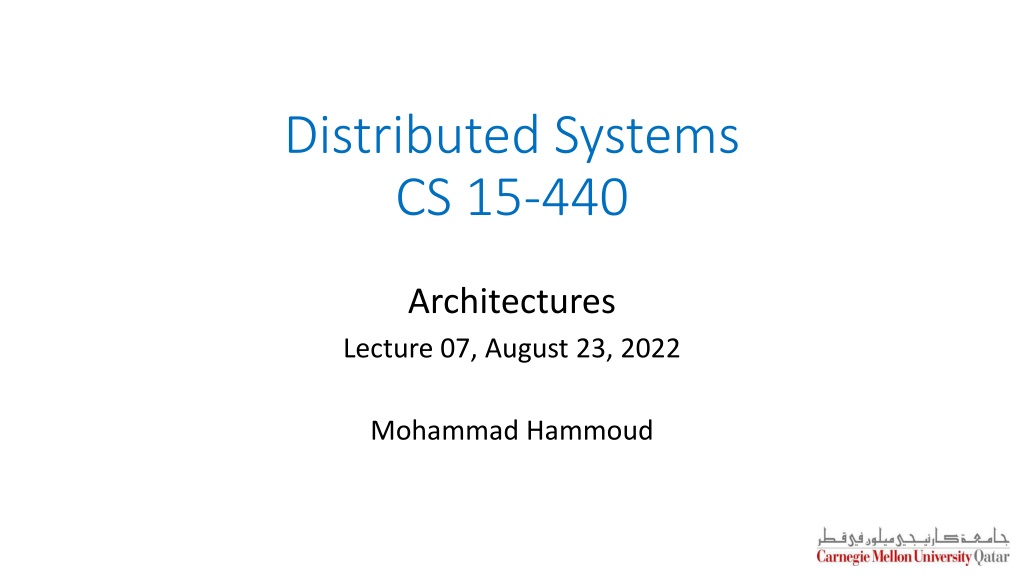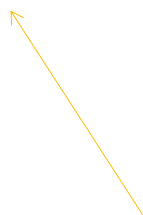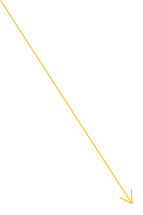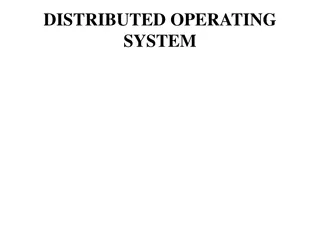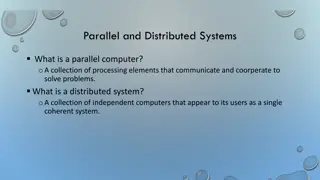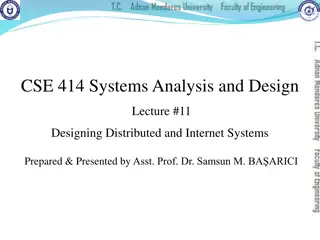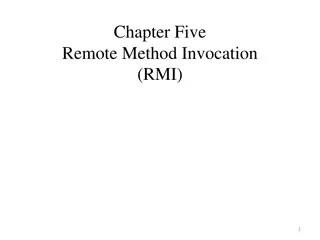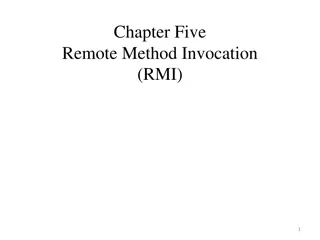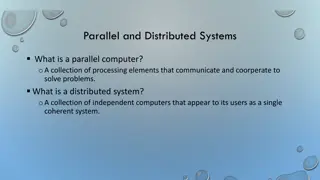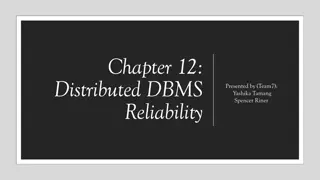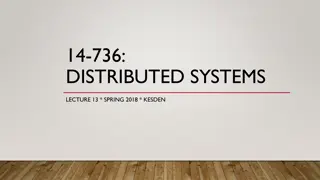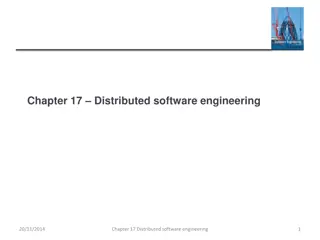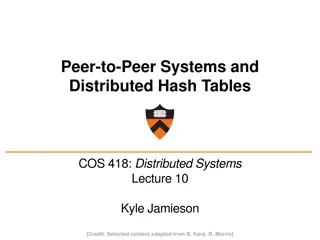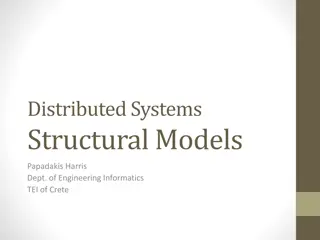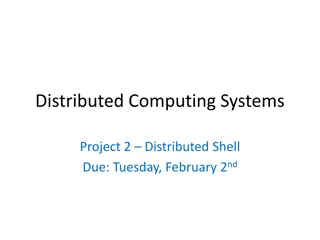Distributed Systems CS 15-440
Dive into the world of distributed systems architectures with insights on peer-to-peer and master-slave structures, communication paradigms, and entity roles. Explore the characteristics, communication patterns, and organizational aspects of distributed systems to enhance your knowledge in this dynamic field.
Uploaded on Feb 21, 2025 | 0 Views
Download Presentation

Please find below an Image/Link to download the presentation.
The content on the website is provided AS IS for your information and personal use only. It may not be sold, licensed, or shared on other websites without obtaining consent from the author.If you encounter any issues during the download, it is possible that the publisher has removed the file from their server.
You are allowed to download the files provided on this website for personal or commercial use, subject to the condition that they are used lawfully. All files are the property of their respective owners.
The content on the website is provided AS IS for your information and personal use only. It may not be sold, licensed, or shared on other websites without obtaining consent from the author.
E N D
Presentation Transcript
Distributed Systems CS 15-440 Architectures Lecture 07, August 23, 2022 Mohammad Hammoud
Today Last Session: Remote Procedure Calls Part II Today s Session: Architectures Announcements: P1 design report is due on August 28 PS2 is due on September 1
Birds Eye View of Some Distributed Systems Peer 2 Google Server Expedia Peer 1 Peer 3 Search Client 1 Client 1 Search Client 2 Client 2 Search Client 3 Client 3 Reservation Reservation Reservation Peer 4 Bit-torrent BlockChain/BitCoin Google Search Airline Booking How would one characterize these distributed systems?
Simple Characterization of Distributed Systems What are the entities that are communicating in a DS? a) Communicating entities (system-oriented vs. problem-oriented entities) How do the entities communicate? b) Communication paradigms (sockets and RPC we will see study more paradigms later) What roles and responsibilities do the entities have? c) This could lead to different organizations (referred, henceforth, to as architectures)
Architectures Two main architectures: Master-Slave architecture Roles of entities are asymmetric Peer-to-Peer architecture Roles of entities are symmetric
Architectures Peer-to-Peer Master-Slave Super-Peer Peer Worker Peer Worker Master Worker Peer
Master-Slave Architecture A master-slave architecture can be characterized as follows: 1) Nodes are unequal (there is a hierarchy) Vulnerable to Single-Point-of-Failure (SPOF) 2) The master acts as a central coordinator Decision making becomes easy 3) The underlying system cannot scale out indefinitely The master can render a performance bottleneck as the number of workers is increased
Peer-to-Peer Architecture A peer-to-peer (P2P) architecture can be characterized as follows: 1) All nodes are equal (no hierarchy) No Single-Point-of-Failure (SPOF) 2) A central coordinator is not needed But, decision making becomes harder 3) The underlying system can scale out indefinitely In principle, no performance bottleneck
Peer-to-Peer Architecture A peer-to-peer (P2P) architecture can be characterized as follows: 4) Peers can interact directly, forming groups and sharing contents (or offering services to each other) At least one peer should share the data, and this peer should be accessible Popular data will be highly available (it will be shared by many) Unpopular data might eventually disappear and become unavailable (as more users/peers stop sharing them) 5) Peers can form a virtual overlay network on top of a physical network topology Logical paths do not usually match physical paths (i.e., higher latency) Each peer plays a role in routing traffic through the overlay network
P2P Types Types of P2P Architecture Unstructured Structured Hybrid
P2P Types Unstructured P2P: The architecture does not impose any particular structure on the overlay network Advantages: Easy to build Highly robust against high rates of churn (i.e., when a great deal of peers frequently join and leave the network) Main disadvantage: Peers and contents are loosely-coupled, creating a data location problem Searching for data might require broadcasting
P2P Types Types of P2P Architecture Unstructured Structured Hybrid
P2P Types Structured P2P: The architecture imposes some structure on the overlay network topology Main advantage: Peers and contents are tightly-coupled (e.g., through hashing), simplifying data location Disadvantages: Harder to build For optimized data location, peers must maintain extra metadata (e.g., lists of neighbors that satisfy specific criteria) Less robust against high rates of churn
P2P Types Types of P2P Architecture Unstructured Structured Hybrid
P2P Types Hybrid P2P: The architecture can use some central servers to help peers locate each other A combination of P2P and master-slave models It offers a trade-off between the centralized functionality provided by the master-slave model and the node equality afforded by the pure P2P model In other words, it combines the advantages of the master-slave and P2P models and precludes their disadvantages
Architectural Patterns Aside from architectures, primitive architectural elements can be combined to form various patterns via: Tiering Layering Tiering and layering are complementary Tiering = horizontal splitting of services Layering = vertical organization of services
Tiering Tiering is a technique to: 1. Organize the functionality of a service, 2. and place the functionality into appropriate servers Airline Search Application Display UI screen Get user Input Get data from database Rank the offers
A Two-Tiered Architecture How would you design an airline search application? EXPEDIA Airline Search Application Display user input screen Get user Input Airline Database Display result to user Rank the offers Tier 1 Tier 2
A Three-Tiered Architecture How would you design an airline search application? EXPEDIA Airline Search Application Display user input screen Get user Input Airline Database Display result to user Rank the offers Tier 1 Tier 2 Tier 3
A Three-Tiered Architecture Application Logic Data Logic Presentation Logic User view, and controls Application- Specific Processing Database manager User view, and control Application- Specific Processing Tier 1 Tier 2 Tier 3
Three-Tiered Architecture: Pros and Cons Advantages: Enhanced maintainability of the software (one-to-one mapping from logical elements to physical servers) Each tier has a well-defined role Disadvantages: Added complexity due to managing multiple servers Added network traffic Added latency
Layering A complex system is partitioned into layers Upper layer utilizes the services of the lower layer A vertical organization of services Layering simplifies the design of complex distributed systems by hiding the complexity of below layers Layer 3 Control flows from layer to layer Response flow Request flow Layer 2 Layer 1
Layering Platform and middleware Distributed systems can be organized into three layers: 1.Platform Low-level hardware and software layers Provides common services for higher layers 2.Middleware Masks heterogeneity and provides convenient programming models to application programmers Typically, it simplifies application programming by abstracting communication mechanisms Applications Middleware Operating system 3.Applications Platform Computer and network hardware
Next Class Naming
